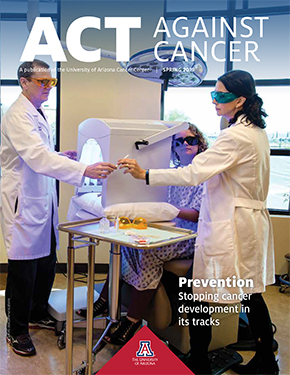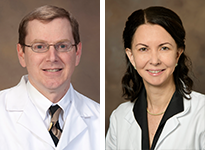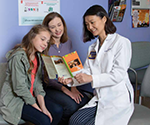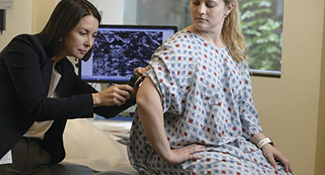 UA dermatologists James Sligh, MD, PhD, and Clara Curiel-Lewandrowksi, MD, made the cover of the latest edition of the Act Against Cancer newsletter from the University of Arizona Cancer Center, out earlier this month with the main theme for this issue being chemoprevention.
UA dermatologists James Sligh, MD, PhD, and Clara Curiel-Lewandrowksi, MD, made the cover of the latest edition of the Act Against Cancer newsletter from the University of Arizona Cancer Center, out earlier this month with the main theme for this issue being chemoprevention.
 In the cover image, the physicians are using photodynamic therapy to treat “precancerous” skin cells, which are targeted for destruction by a specific wavelength of light.
In the cover image, the physicians are using photodynamic therapy to treat “precancerous” skin cells, which are targeted for destruction by a specific wavelength of light.
The photo goes with the cover story on “Skin Cancer Chemoprevention,” which begins on p. 8 of the full newsletter found at this link [PDF]. The article and another from this issue, “Healing in Motion,” can also be found on the UA Cancer Center’s newly redesigned website here and here.
Megan Guthrie, UACC communications and public affairs director, noted that the rest of articles in this issue of Act Against Cancer will be rolled out as individual posts on the center's website in the coming weeks. See the full index of articles in the newsletter below:
Act Against Cancer | Spring 2019
IN THIS ISSUE:
“A Note to Our Friends and Supporters” | p. 1 – Message from Andrew S. Kraft, MD
 “What Is Chemoprevention?” | p. 4 – Sherry Chow, PhD, co-leader of the UA Cancer Center’s Cancer Prevention and Control Program and director of the UA Early Phase Chemoprevention Consortium, devotes her career to chemoprevention, “a field that needs more attention.”
“What Is Chemoprevention?” | p. 4 – Sherry Chow, PhD, co-leader of the UA Cancer Center’s Cancer Prevention and Control Program and director of the UA Early Phase Chemoprevention Consortium, devotes her career to chemoprevention, “a field that needs more attention.”
“The Deal with Placebos” | p. 7
“Skin Cancer Chemoprevention: Slowing, Stopping or Reversing a Skin Cell’s Journey to Cancer” | p. 8 – The sun’s ultraviolet (UV) rays are the primary cause of skin cancer, and although they are hard to avoid in Arizona, many steps can be taken to reduce skin-cancer risk.
 “Healing in Motion” | p. 14 – Restoring Balance, an exercise program coordinated through the Partnership for Native American Cancer Prevention — a collaboration between the UA Cancer Center and Northern Arizona University — is tailored for a Native population and meets standards set by the American College of Sports Medicine. It seeks to meet people where they are — physically, culturally and clinically.
“Healing in Motion” | p. 14 – Restoring Balance, an exercise program coordinated through the Partnership for Native American Cancer Prevention — a collaboration between the UA Cancer Center and Northern Arizona University — is tailored for a Native population and meets standards set by the American College of Sports Medicine. It seeks to meet people where they are — physically, culturally and clinically.
 “A Shot at Prevention” | p. 20 – By learning about their immune response, we could defend more children against a cancer-causing virus, says Yi Zeng, MD, PhD, who hopes more preteens and teens will receive the HPV vaccine.
“A Shot at Prevention” | p. 20 – By learning about their immune response, we could defend more children against a cancer-causing virus, says Yi Zeng, MD, PhD, who hopes more preteens and teens will receive the HPV vaccine.
“An Intervention with Heart” | p. 24 – The LIvES (Lifestyle Intervention for Ovarian Cancer Enhanced Survival) study, led by Cynthia Thomson, PhD, RD, uses the power of personal connections to help ovarian cancer survivors forge healthier habits. Others featured in this article include: Tracy Crane, PhD, and John Farley, MD.
 “Donor Patient Profile: Jack Wilson — Lymphoma Survivor” | p. 30
“Donor Patient Profile: Jack Wilson — Lymphoma Survivor” | p. 30
“A Family’s Mission to Keep a Memory Alive through Research and Crowdfunding” | p. 32 – In memoriam to Joan Luft Cohen.
Avoiding Skin Cancer
The “Skin Cancer Chemoprevention” article, focuses largely on the work of Dr. Curiel and Sally Dickinson, PhD, a research assistant professor in the Department of Pharmacology. It notes some of the nation’s best skin cancer research takes place here at the UA Cancer Center, which houses the UA Skin Cancer Institute, a locus of patient care, research, and community outreach and education.
 Regarding the best prevention, Dr. Curiel said, “I would love to see the Tucson International Airport have a big sign.” What would it say? “Welcome to Arizona. Put on Sunscreen and Wear Your Hat. Don’t Let Skin Cancer Be Your Souvenir!”
Regarding the best prevention, Dr. Curiel said, “I would love to see the Tucson International Airport have a big sign.” What would it say? “Welcome to Arizona. Put on Sunscreen and Wear Your Hat. Don’t Let Skin Cancer Be Your Souvenir!”
Dr. Curiel is director of the UA Cancer Center’s Cutaneous Oncology Program and Pigmented Lesion Clinic, clinical director for the UA Skin Cancer Institute, and a professor of medicine and vice chief of the Division of Dermatology in the UA College of Medicine. In 2018, she was honored by the Arizona Bioindustry Association as the Arizona Bioscience Researcher of the Year for her work on both the treatment and prevention of skin cancer.
Dr. Sligh is a professor of medicine, chief of the Division of Dermatology, and associate director of the UA Skin Cancer Institute. He sees patients at Banner – University Medical Center Tucson, the UA Cancer Center’s Peter and Paula Fasseas Cancer Clinic (North Campus), as well as the Tucson VA Medical Center as a staff physician at the Southern Arizona VA Health Care System.
Look for the latest notices from the UA Cancer Center on its “News and Information” webpage: cancercenter.arizona.edu/news-information

